| Bible Ki Kahaniyan | |
|---|---|
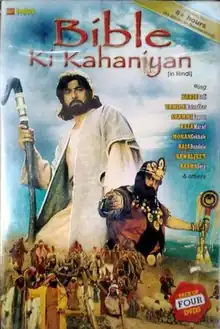 DVD cover of Bible Ki Kahaniyan. | |
| Genre | |
| Based on | Bible |
| Developed by | Navodaya Appachan |
| Written by | Bhushan Banmali Zackaria |
| Directed by | |
| Creative director | Jijo Punnoose |
| Starring | See Cast |
| Voices of | Arvind Mehra Lalit Tiwari |
| Narrated by | Lalit Tiwari |
| Theme music composer | Karthik Raja |
| Opening theme | "Ashkon se Jisne Seenchi Zameen" by Karthik Raja |
| Composers | Louis Banks Mohan Sitara Vanraj Bhatia Karthik Raja Sharreth |
| Country of origin | India |
| Original language | Hindi |
| No. of seasons | 1 |
| No. of episodes | 6 |
| Production | |
| Producer | Jose Punnose |
| Cinematography | Ashwini Kaul Ramachandrababu |
| Editors | Raghupathy T. R. Shekhar |
| Camera setup | Single-camera |
| Running time | 50 minutes |
| Production company | Navodaya Studio |
| Original release | |
| Network | DD National |
| Release | 20 December 1992 – 1996[1] |
Bible Ki Kahaniyan (transl. Stories from the Bible) is an Indian Hindi-language television program based upon scriptures from the Bible. The production aspired to complete both Old Testament and New Testament narratives of the Bible but was later discontinued after covering the Patriarch narrative in the Book of Genesis.[2] It was produced by Appachan through his Navodaya Studio and was broadcast on DD National from 1992 to mid 1993 and again, concluding with the remaining episodes, in 1996.[1]
Premise
The series follows these narrative arcs from the Bible:[3]
- Adam & Eve
- Noah's Ark
- Tower of Babel
- Story of Abraham
- Story of Isaac (Genesis 24:63–64, 25:21–22)[4]
- Story of Jacob (Genesis 27:31–44, 28:1–5)[5]
Cast
.jpg.webp) Raza Murad as Noah
Raza Murad as Noah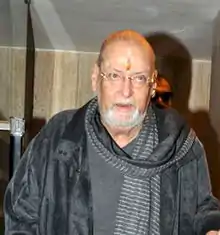
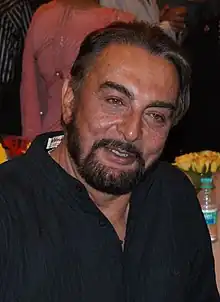
- Lalit Tiwari as Narrator
- Arvind Mehra as Voice of God
- Mother Teresa as Herself(Regarding the episode about Noah's ark)
- Daman Maan as Adam
- Soham as Eve
- Varun Vardhan as Cain
- Rajesh Kapoor as Abel
- Raza Murad as Noah
- Asha Sharma as Noah's wife
- Leela Panicker
- Urmila Matondkar as Noah's wife's niece
- Kothuku Nanappan
- Shammi Kapoor as Nimrod
- Jagannathan as Manokh
- Misha as Aman
- Sneha as Nimrod's wife
- Kabir Bedi as Abraham
- Radha Seth as Sarah
- Anamika as Hagar
- Surendra Pal as Eliezer
- Raja Bundela as Lot
- Vishwajeet Pradhan as Nimuk
- Seshad Khan as Ishmael
- Akbar Khan as Amorite/Main priest
- Karan Saluja as King of Sodom/Bethuel
- Bhushan Banmali as Hittite
- Ravi Vaswani/Rajendra Gupta as Laban
- Mohan Gokhale/Kurush Deboo as Isaac
- Mita Vashisht/Neelima Azeem as Rebecca
- Rita Bhaduri as Deborah
- Kanwaljit as Jacob
- Salil Shukla as Young Jacob
- Janak Toprani as Esau
- Master Patnaik as Young Esau
- Satish Kapoor as Abimelech
- Vijay Mehta as Phicol
- Virendra Saxena as Ahusat
- Sanofar as Altamash
- Aruna Sangal as Cannanite priestess
- Ketan Merchant/Prince George as Hittite kids
- Winnie Paranjpe as Leah
- Sunila Karambelkar as Rachel
- Vasudev Bhatt as Ibduil
- Tamara George as Bilhah
- Chanda as Zilpah
- Saba as Laban's wife
- Aakash Chopra as Reuben
Background and production
Jijo, the series' creative director, based his chief reference point on novelist James Michener's The Source, a book that talks about the "pains and passions of the people in Biblical times".[6][7] Casting was done by Anant Mahadevan and Meenakshi Thakkur and the characters were played by some of the important actors from Bollywood.[8] Much of the production work was done by people from the Malayalam film industry based in the state of Kerala.[7][lower-alpha 1] Indian historian George Menachery served as the research director, Sabu Cyril was the art director and Sunny Joseph worked on title photography, with additional cinematography by Ashok Kumar, the series had H. Sridhar as a music recordist, SL Puram Anand was the production executive, and Muthuraj served as an assistant art director.[4][10] Editing work was done on Avid Media Composer and the series was shot on Kodak Super 16.[4] Post-production was handled by Prasad Studios and Seventh Channel Communications.[11][4]
Filming and locations


The series was shot on different locations in India per the narrative arcs: Kallar and Kanyakumari (Adam and Eve),[11] Kanyakumari (Noah's Ark); episodes beginning with Patriarch arc which required desert scenery were shot in the state of Rajasthan (home of the Thar Desert) mainly in Pushkar and Ajmer; and Tirunelveli in Tamil Nadu (Abraham).[12][lower-alpha 2] The shooting was supported by organisations such as the Kerala Forest and Wildlife Department, Rajasthan Tourism Development Corporation, Ajmer Military School among others and received production assistance from the Government of Israel, Israeli Antiquities Authority, Indian Ministry of Foreign Affairs, and N. Ram of The Hindu.[4][5] Animals required for the Noah's Ark sequence were provided by Bharat Circus.[14]
Research
Additional people credited and referred to for research work on the Patriarch episodes included Bishop Alphonsus Mathias of the CBCI, Antony Padiyara, Aharon Megged, Asher Weill, T. Carmi, Amihai Mazar, Jack Sasson, Avraham Biran, David Ussishkin, Trudi Dothan, R.J. Zwi Werblowsky, Nissim Ezekiel, Dom Moraes, Leela Naidu.[4][5]
These institutions were also credited: Bible Lands Museum, Biblical Archaeology Society, British Council - Madras, Connemara Public Library, Eretz Israel Museum, Film Institute - Tel Aviv, Hebrew University, Indian Theosophical Society Library, Jawaharlal Nehru University Library, Jnana Deepa Institute for Philosophy and Theology, Orthodox Theological Seminary - Kottayam, Ratan Tata Library, Reader's Digest Association, National Centre for the Performing Arts, National Geographic Society, Steven Spielberg Jewish Film Archive, Israel Museum, and the University of Madras.[4][5]
Sources consulted
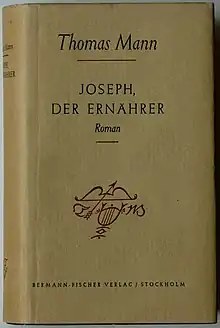
- Books
A number of religious texts and scholarly sources were consulted for the Patriarch episodes, these included:[4][5]
- Articles

Articles referred to in the production of the Patriarch episodes included:[4][5]
- "Journey into the Living World of the Bible" by Melville Bell Grosvenor (Oct 1967)
- "Splendors of the Bronze Age" by George F. Bass (Dec 1987)
- "Bringing Old Testament Times to Life" by G. Ernest Wright (Dec 1957)
Bible Review/Biblical Archaeology Review
- "The Mothers of Israel" by J. Cheryl Exum (Spring 1986)
- "Patriarchal Burial Site Explored for First Time in 700 Years" by Nancy Miller (May–June 1985)
- "Ekron of the Philistines" by Trude Dothan and Seymour Gitin (Jan/Feb 1990)
- "Elie Borowswki Seeks a Home for his Collection" by Hershel Shanks (Mar/Apr 1985)
- "Exploring Philistine Origins on the Island of Cyprus" by Vassos Karageorghis (Mar/Apr 1984)
- "Jacob Takes his Bride" by Thomas Mann (Spring 1986)
Music
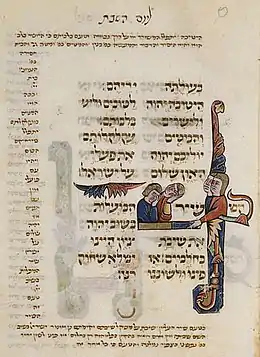
The title song by music director Karthik Raja was based on Psalm 126:5–6.[11] The Patriarch episodes had lyrics written by Kaifi Azmi and Hasan Kamaal with songs sung by Kavita Krishnamurti, Vinod Rathod, Suresh Wadkar, and Vani Jairam.[10] These episodes included recreated Hurrian songs by Anne Draffkorn Kilmer, and Ancient Greek music by Gregorio Paniagua. Music from "The Music of the Bible Revealed, Tapes and the Book" by Suzanne Haïk-Vantoura, and "The Rise of Ancient Israel" by the Biblical Archaeology Society was also included in these episodes with Vantoura also serving as an advisor.[4][5]
Broadcast and release
Broadcast
The first Episode "Adam and Eve" aired on 20 December 1992 on DD National. DD discontinued the series after few episodes because there was fear of communal tension as some people, particularly in Jammu and Kashmir, had objections with the portrayal of Islamic prophets on screen.[15]
Home media
A 4 disk set of Bible Ki Kahaniyan was released on DVD by Indus Video in the NTSC standard, containing all six episodes of the series that were broadcast by Doordarshan.[3]
See also
Further reading
- Agarwal, Amit (15 January 1993). "TV serial 'Bible Ki Kahaniyan' emphasises more on authenticity than spectacle". India Today.
- Democratic World. Vol. 21. Gulab Singh & Sons. 1992. pp. 34–36.
Notes
- ↑ Kerala has a significant Christian minority, especially the historical community of Saint Thomas Christians.[9]
- ↑ The site of St. Francis Xavier's first missionary activity in India.[13]
References
- 1 2 Ananth Mahadevan (20 July 2020). Once Upon A Prime Time: My Journey on Indian Television. Embassy Books. pp. 97–. ISBN 978-93-89995-09-1.
- ↑ Maria Francesca Piredda (2005). Film & mission: per una storia del cinema missionario. Ente dello Spettacolo. p. 41. ISBN 978-88-85095-26-7.
- 1 2 "Bible Ki Kahaniyan [4 DVD Set] DVD (1993)". Induna.com.
- 1 2 3 4 5 6 7 8 9 10 Bible Ki Kahanya - Story of Isaac, retrieved 18 May 2021
- 1 2 3 4 5 6 7 Jacob, retrieved 18 May 2021
- ↑ "The Third Coming - the Indian Post". Archived from the original on 25 July 2011. Retrieved 23 February 2011.
- 1 2 "TV serial 'Bible Ki Kahaniyan' emphasises more on authenticity than spectacle". 15 January 1993. Retrieved 27 December 2018.
- ↑ "Indian television has a long way to go: Kabir Bedi - Indian Express". archive.indianexpress.com.
- ↑ Thomas Christians at the Encyclopædia Britannica
- 1 2 "Bible Ki Kahaniya". nettv4u. Archived from the original on 25 April 2015. Retrieved 14 May 2021.
- 1 2 3 Bible Ki Kahaniya - Adam & Eve, retrieved 14 May 2021
- ↑ Abraham, retrieved 18 May 2021
- ↑ Tirunelveli. Collins English Dictionary, 12th Edition 2014.
- ↑ Bible Ki Kahaniya - Noah's Ark, retrieved 19 May 2021
- ↑ "More mythology on DD's Sunday slot". Archived from the original on 28 September 2011. Retrieved 23 February 2011.